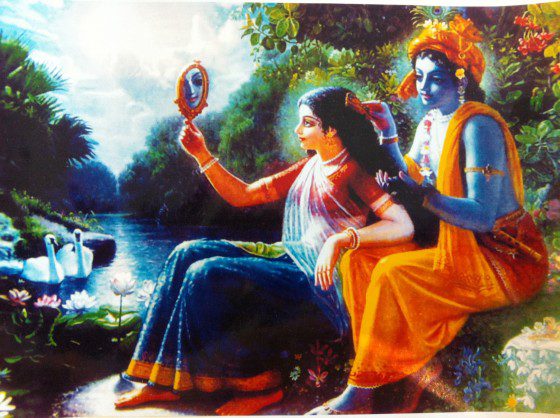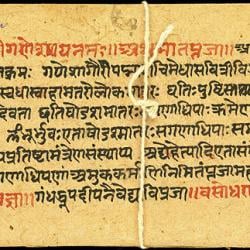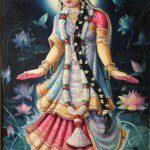In Hinduism there are 16 major life rituals called Samskars or Sanskars (संस्कार) and one of them relates to a husband and wife conceiving a child. My husband and I want to have children and so this is the perfect opportunity to fulfill a samskar (although, I think the samskar counts as part of the child’s life!)
When I was in India I picked up a copy of this book…
It has a lot of long-winded essays about why more people should be doing these rituals but in the second half it also has very detailed information on exactly how to do them!
So read on and together we’ll learn how to align with the universe and the Gods to bring a good soul into our family…
It seems that this samskar is considered part of the baby’s life rituals and that’s probably why it’s always first on the list when you look up 16 Hindu Samskars. If the samskar were part of the parent’s life rituals, then it would come after the marriage one, no? So, if your parents didn’t do a garbhadhan for you, then I guess you’ll never collect them all. So sad.
Oh well. Nothing to be done about that except do the ritual for my own babies. I think a ritual like this could help my mind prepare for this step that we’re taking. Rituals can be really nice for signaling a change to one’s subconscious.
An interesting note. The book says this ritual should be performed from the 5th day until the 16th day from the start of the woman’s menstrual period. Even back in ancient times they must have known something about the science of conception, because that is indeed pretty much the fertile time for the average woman! He mentions that Manu suggests avoiding the 11th and the 13th nights but doesn’t say why. He also believed that sex on even nights would produce boys and sex on odd nights would produce girls. I don’t think I’ll be testing that one out. (It looks like the details for these rituals nearly all come from the writings of Manu, said by some to be the first man).
So, how exactly do we do this?
It’s pretty involved. I will probably do a simplified version, but here’s the entire run down:
- The couple must remain fresh and happy on the fixed day (Unhappiness will not produce good children)
- At noon the couple should perform a Ganesh Puja (See below for the details on this)
- Before evening the lady should take a bath, wear new clothes, ornaments and garlands of fresh flowers
- She should sit in a place fixed for puja and face east. Other married ladies who have children should offer her wheat, oats, and coconut while the husband chants (see below for the husband’s mantra)
- In the second part of the night, the couple should enter a room decorated for this purpose, clad in white clothes.
- The wife lies flat on a soft bed (I did not encounter any soft beds when I was in India, fyi!) The husband sits facing east and performs a Upastha Sparsha Kriya (see below)
- Have sex
- After, the wife sits up and the husband performs a final mantra (see below)
Ganesha Puja
The book doesn’t specify exactly how to do the Ganesh Puja, but just gives a mantra to put into the puja. So, here is a Ganesh Puja intended for Chathurti (modified from http://www.ehow.com/how_6961387_do-ganesh-puja.html) with the specified mantra inserted…
Make sure the house is clean. Bathe and put on fresh clothes.
- Place coconut leaves around the platform on which the idol will be put.
- Add garlands of red roses.
- Wash and dry the murti and stand it on the platform with more flowers.
- Add sandalwood paste to the image and clean your hands
- Recite a mantra (the webpage has a number of suggestions, but here is the mantra from the book):
Aum ganaanaantwaa ganapati ganghwaa mahe priyaanantwaa priyapati
ganghwaa mahe nidhinantwaa nidhipati ganghwaa vaso mam
aahamjajaanigarbhadhamaa twamajaasi garbhadham
- Place modak sweet and rice next to the murti, saying “Aum Sri Ganesha Namah”
- Light the incense and lamp
- Perform the Shhodashopashara (the site mentions this, but not what it is. After some more research I find that this is the 16 steps of a basic puja, as follows)
- Wash the Ganesha’s hands and feet, offer him water to drink while saying “Aum Shri Ganesha Namah Achmanee Yam Samarpayami.”
- Recite the 108 names of Ganesha (these describe particular features of the God).
Husband’s Mantra
Aum yeh bhaliniryaam afalaa apushpaa yaashya pushpini.
I recorded a video for all the Sanskrit mantras in this ritual. They are at Vimeo and password protected. The password is “Hinduism.” Let me know if you have any trouble with this! (I’m not the best at Sanskrit pronunciation, but I hope that it will just give you a basic idea).
This one is given a translation: “May your vagina be made potent for conception and may the Lord bestow His grace up on you so that the foetus grows happily and does not abort before ten months.”
He then touches the Upastha (sexual organs! ) with three fingers and recites three more mantras:
Final Mantra
The wife is now sitting up and the husband places his right hand on her right shoulder then touches her heart (with his other hand, presumably) and says:
Yikes. That’s a lot of Sanskrit for my poor husband to learn. Well, we’ll do our best.

I know for sure that we will not be doing the having other married ladies with children giving me blessings. I don’t know enough in my area and I’d feel really weird about it. I may let my best friend who has a seventeen-month-old and lives down the street from me know that we’re doing this and ask her to be thinking positive thoughts for me on the day we pick. (I don’t foresee doing this ritual every single fertile day of my cycle, but then again it’s very difficult for me to pinpoint my fertile days because I have PCOS.)
I really like the clean and decorated room and special clothes to help the moment feel important and weighty.
What do you think? Would you do a ritual like this? Would you modify it?















